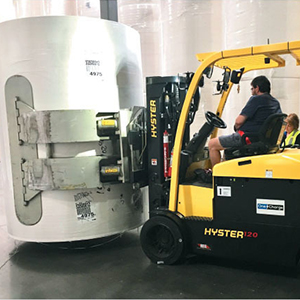
Clean, customizable, and not as new as you think, lithium-ion batteries may be poised to transform the way mills charge up.
A typical pulp bale or paper roll may be moved, stored, stacked, loaded, or unloaded a dozen or more times before it gets where it needs to go. Every stage of this transport chain requires powerful, specialized handling equipment that can add cost, maintenance, bottlenecks, and pollutants to the bottom line.
Lithium-ion (also called lithium or Li-ion) batteries may be a solution—they offer benefits that seem tailor-made for the pulp, paper, and packaging industries. Plus, the technology is not as new as some people think, says Mark D’Amato, Vice President of Sales for OneCharge in Irvine, CA.
« The technology really began about 1996, » he says. « Part of our quest is to get people away from the fear that lithium technology is too new, or untested. In the material handling area, it’s about 7-10 years old. »
In the US, acceptance of Li-ion batteries has been regional, beginning on the West Coast. « Then it hop-scotched across to the East Coast, and now it’s starting to work its way into the Midwest, and moving North and South, » D’Amato says.
The pulp and paper industry is a « borderline » industry for Li-ion technology. Its material handling needs fall between those industries that, traditionally, have always been able to use electric forklifts, such as small warehouses and supermarkets; and ultra-heavy industries, such as mining, where gigantic machinery consumes so much energy that conventional wisdom suggests it cannot be converted to electric power. « We’re proving that that isn’t true, » says OneCharge Marketing Director Maxim Khabur. « The paper industry is one of the first heavier industries to begin adopting Li-ion, but others will follow. »
Pulp and paper facilities are ready to make the switch because, in general, they have access to electricity and a stable infrastructure with a grid that is consistent; many mining operations, in contrast, are in undeveloped areas. « Our batteries offer a lot of potential for paper handling, » says D’Amato. « Plus, where sanitary handling is a mandate—like in paper converting and packaging, including food packaging—a lack of hazardous fumes and low maintenance are important. »
Benefits of Li-ion
Material handling operations use a wide range of powered equipment, from regular pallet jacks to specialty equipment with very non-standard battery compartments, to heavy-lifting trucks with high power requirements. Li-ion batteries have very high power density and can replace lead-acid or internal combustion—gasoline, propane, or diesel—in lift trucks or specialty equipment.
Li-ion batteries differ significantly from the more common lead-acid batteries—the type used in most automobiles, as well as in many kinds of lift truck. While a car battery is typically 12 volts, lift truck batteries can be 24, 36, 48, or even 80 volts.
With a lead-acid battery, the truck is usually tied to a cycle of eight hours of use, eight hours of charge, and eight hours of cooling every day to accommodate acid level maintenance and other care requirements, says D’Amato. « It’s a really delicate process if done right; people who do it right can make their lead-acid batteries last a long time. Unfortunately, the reverse is also true. If people are careless, they’ll have issues such as low run times, sulfating of the battery, and even acid leaking onto the floor. With lead-acid batteries, maintenance can become such an issue that instead of batteries lasting five or six years, they last three or four years. »
In addition, a warehouse charging room requires air conditioning and ventilation fans to mitigate the toxic gasses released when lead-acid batteries are charging. This is not a concern with Li-ion batteries. « Concerns about corrosive acid go away. Handling of batteries and switching at the beginning and end of each shift goes away, » D’Amato says. « You can take that charging room space and put it to its highest and best use, as opposed to just being overhead. »
Other benefits of Li-ion batteries include:
- Charging
– More flexible charging time: « opportunity charging » (ie, charging anywhere during even short periods of downtime, like lunch breaks)
– No off-season maintenance: a Li-on battery can be turned OFF and sit idle for 3-9 months at a time, then be turned ON and put right into service with negligible power loss
– Fast charge (2 hours or less) with no « memory » effect
- Performance
– Fast lifting and travel speeds at all levels of discharge (no voltage drop)
– Single battery operation through multiple shifts with opportunity charging
– Service life > 3,000 cycles
- Reduced Cost
– Longer life span: Li-ion batteries’ expected useful life is at least 2x lead-acid. Using a typical new Lift FMV lease, Li-on may last for two three-year lease terms. After that, it may still be possible to transfer it to used equipment or have it repurposed (e.g. for energy storage)
– Zero daily maintenance
– Less wear on lift truck components
For pulp and paper makers, sustainability is another factor. Realizing that many of his customers had internal mandates to reduce their mills’ carbon footprint was a « lightbulb moment » for D’Amato. « Lift trucks may not even be an area they’re considering to help meet those goals, » he says. « Switching from internal combustion to lithium means going from fossil fuels to electricity. You’re not doing engine, transmission, or differential oil changes; the lift is not emitting carbon. The efficiencies are prevalent for every industry.
« Plus, you’re going to save money all the way around against lead-acid or internal combustion. In the US it can be 10-15 times as expensive to run an internal combustion truck, depending on where you live and work. Our experience is that we can help reduce someone’s total cost of ownership by 25-30 percent over five years, » he adds.
Application-driven
For any industry, says D’Amato, the adoption and use of Li-ion batteries should be application-driven. « Take a look at your material handling equipment; deciding factors include how high they lift, what they lift, and what cool gadgets can be put on the front of the lift. In the paper industry, that can often be a bale clamp or paper roll clamp. Those can be very heavy, so the trucks can get very big. Smaller trucks might have a push-pull on them, or a fork positioner. The bigger ones will have big, 4,500-lb. clamps that are lifting paper rolls that are 60 inches across. That changes everything. »
The best approach is to take a survey of mill operations, note what kind of lifts are already owned, outline the workload, and determine available charging times, he says. « Then we work through the lift truck dealer to offer some choices. It’s a consultative, problem-solving approach. »
D’Amato notes that the biggest challenge is not finding an application that can be improved with Li-ion batteries; it is overcoming the fear that decision-makers can have about switching to a newer technology. Yet he likens Li-ion batteries to using a cell phone: once you’re used to it, you feel you cannot live without it.
« That’s what’s happening with lithium, » he explains. « When we install that equipment and it works like it’s supposed to work, there’s nothing prettier. Any company that gets it in their mill, the drivers ask, ‘Man, where were you five years ago?’ We were here, you just weren’t listening. »

Hyster lift truck with a paper roll clamp powered by a lithium battery
Li-ion at Work: 2 Case Studies
As any mill manager can tell you, the high-volume, uninterrupted handling of paper rolls, pulp, and scrap bales requires powerful, reliable material handling equipment. Until recently, Class I and II lift trucks and AGVs that employ tilting and rotating attachments were powered mainly by liquefied petroleum gas (LPG) internal combustion engines or lead-acid electric. Both have their own set of issues, but the three major problems were common: limited runtime, high energy costs, and pollution.
Lithium-ion batteries are better suited to meet the needs of the paper industry’s three-shift-a-day operations, says Maxim Khabur of Irvine, CA-based OneCharge. OneCharge produces 600 models of Li-ion batteries using a lithium iron phosphate (LiFePO4) chemistry.
« We’ve helped customers switch from LPG to electric or from lead-acid to Li-ion batteries to successfully move paper rolls and bales through the supply chain. OneCharge batteries support the handling of large size rolls in paper mills and printing/converting houses. »
Khabur says that today’s Li-ion batteries are powerful enough to support demanding pulp and paper mill applications—illustrating with the following application-specific examples:
Application 1
A US paper mill has switched its end-of-the-line lift trucks to Li-ion batteries. The 12,000 lb.-capacity, electric-powered cushion tire trucks are all 80V, powered by 540Ah OneCharge Li-ion batteries. Four trucks are traveling with the paper rolls to the loading docks, where the rolls are stacked both in cargo trucks and railcars for distribution. There are also two trucks for making shorter trips with rolls that require rewinding.
All six trucks are operating on a single battery each, which will last through the full day with quick « opportunity charging » events during breaks and lunch.
Application 2
A large paper mill uses special AGVs to feed the production line. The end of the line is served by 15 smaller lift trucks, which have all been recently switched from the LPG-powered internal combustion engines to electric Li-ion. There are 12,000 lb.-capacity trucks equipped with 4,000 lb. paper roll clamp, plus 5,000 lb.-capacity trucks with push/pull attachments. The smaller trucks run three shifts a day, averaging 4,800 hours of operation per year, far beyond any industry-standard lease (roughly 1,500-2,000 hours per year).
Li-ion batteries are best for applications that require maximum uptime and safety while handling paper and pulp products, says Khabur. « Lithium batteries help decrease downtime by using breaks for opportunity charging whenever it is most convenient for the operations. Zero daily maintenance and energy efficiency increase the savings. »
This article was originally published in the May-June issue of Paper 360 Magazine.
 by Mark D'Amato | juin 8, 2021
by Mark D'Amato | juin 8, 2021